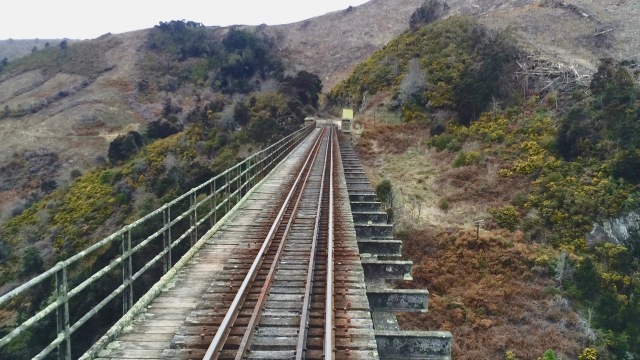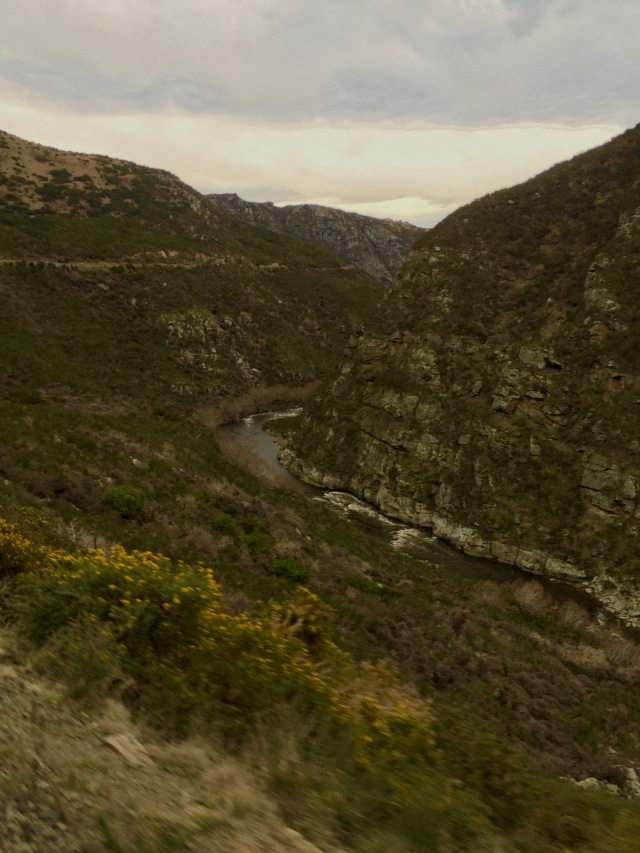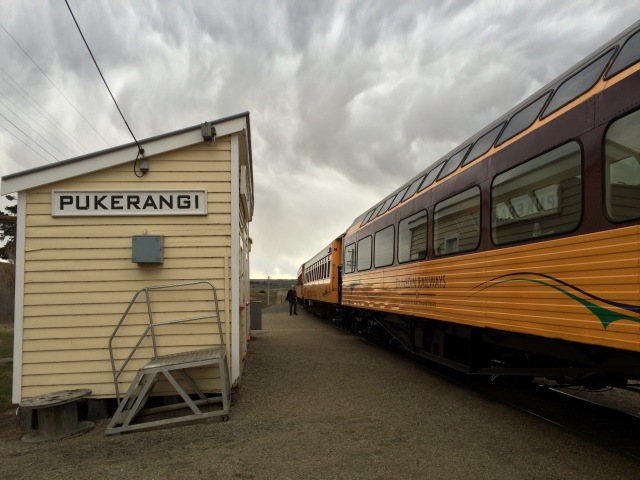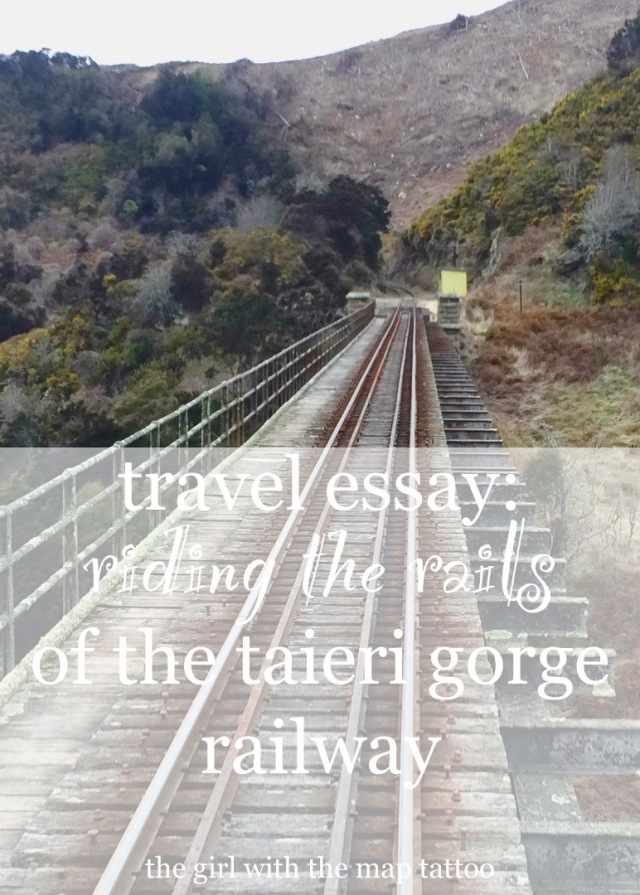I stepped onto the train platform, the cool shadows of the Dunedin Railway Station behind me, its ornate interior all Art Deco meets old world architecture. In front of me, the Taieri Gorge Railway sat waiting silently to take me on an exploratory journey.
Climbing aboard, I found my seat in the carriage next to an Australian man. Our carriage mates included six other Australians and a few Kiwis. It was soon apparent that there weren’t very many people in our carriage so we began to spread out, claiming window seats that faced forward and so on. A voice came over the intercom announcing our imminent departure as soon as we had a safety briefing.
The voice continued to speak of our journey and introduced our drivers, Mike and Chris; the girls in cafe, Caitlin and Claire; Joe, the guard slash souvenir salesman extraordinaire; and the Voice himself, Lyall.
He explained what engines, two of them, were attached to our train today, the DJ diesel class locomotives that replaced the steam engines. He also informed us that someone would be passing out a map of the route, and that he had also “given a copy of the map to our driver so we shouldn’t get lost,” which elicited a chuckle from those in my carriage. Lyall then commenced the safety briefing and then the train began to move.
There was a gentle swaying back and forth as we rolled out of the yard, past the boxcars covered in bright graffiti, past the warehouses, past the piles of rail ties stacked neatly along the track. Joe came into our carriage to check our tickets and to banter about with the Australians. As we entered the Caversham tunnel, there was a buzz of conversation around me. We thundered through, coming out the far end alongside the Southern Motorway. If you’ve ever driven in New Zealand, you have driven along State Highway 1. In the North Island, this is a proper motorway for most of it, except for in the Far North, stretching from Cape Reinga south to Wellington. In the South Island, SH1 picks up in Picton, where the Interislander and Bluebridge ferries disembark passengers, and traverses the length of the east coast, through Kaikoura and Christchurch, to Dunedin and then inland again to meet up with SH6 to finally end in Bluff – the bottom of the country and the gateway to Stewart Island. Here, alongside the Taieri Gorge Railway, it’s a proper motorway, but only for a moment.

We turned in to the plains inland of Mosgiel, at Wingatui, preparing to cross the Taieri Plain, a 300km square stretch of fertile land between the hills and the sea. We also turned off the main rail track here – from the New Zealand-owned mainline to the Taieri Gorge Railway Ltd owned Taieri Gorge Railway – the longest privately owned railway in NZ. The hills ahead stretched out but for the minute I was focused on the plains. Many of the farms we passed were raising horses, or sheep, and there were plenty of babies of both species running amok.
Now that we were on the private rail line, I was able to leave my carriage and walk about the train. I went forward first, to the observation deck between the dining car and the restricted engine cars. Then, I went all the way back to the rear of the train, through the heritage carriages, to the platform on the end. Unfortunately, it was a bit chilly, so I didn’t stand out there for too long! I returned to the warmth of my panoramic carriage and the lively conversation of my Australian carriage companions. It was around now that Joe came in with Cadbury Chocolates for everyone, a nice surprise since I hadn’t had lunch – I savoured the hazelnut nougat. Joe talked up the Cadbury tour too… now to only find a way to combine the Speights-Cadbury-Taieri Gorge Railway experience… *starts brainstorming*
The train climbed steadily higher, to Salisbury and the Salisbury Tunnel, the longest on the line. We wound our way along the Taieri River through the Mullocky Gully, home to logging and former mining endeavours. As we began to climb out of the plains, the flora began to change. The hillsides were covered in gorse, manuka and kanuka trees, bracken, cabbage trees (palms), and stately pines.
Soon Lyall came on with an announcement, we were approaching the Wingatui Viaduct. Now, I don’t want to get all pedantic here, but it’s not really a viaduct. It’s a bridge. An impressive bridge, one of the largest wrought iron structures in the Southern Hemisphere, for that matter, but not a viaduct. Anyway, I grabbed my camera and walked through the train to the rear carriage. The viewing platform here gave panoramic views of the viaduct and the rails as we sped across.
Below us, along the rushing water, there were stark white trees with copper buds. I’ve seen them often, especially in Central Otago, but I’ve never known the name. They’re cracked willows, apparently, and the Taieri Gorge is wild with them. They grow along the rocky banks of the river, a colourful contrast to the dark greens and greys of the rocks and hills above.

Speaking of rocks, the hills grew more sparse. More barren. The Otago schist punctured the surface of the earth at a slant, the distinctive thin layers noticeable even to the naked eye. We clung to the hillside, so close to the rock and the trees that I could reach out and touch it. We crossed more bridges and viaducts, passed through more tunnels. In Hindon, a former crossing station, we stopped for a five minute break. A statue of a dog sits near the small building but I was more interested in taking photos of the train.
The whistle blew suddenly, making me and others jump, but effective in getting us to return to the train carriages. I sat staring out the window for much of the rest of the inland trip, listening alternately to Lyall over the speaker, Joe with his stories gleaned from many years working for the railway, and my carriage companions. We slowed down unexpectedly though, and Lyall informed us that we were having some locomotive trouble. I began to fret that I would be late for work. Within ten minutes, however, the problem was fixed and we were back on our way. We crossed Deep Stream and Flat Stream before approaching the Notches. These are four deep gulches (<what a cool word), rocky and ominous.
This area has a rich gold mining history, and we learned about a lot of it – from the miner camps that grew up on the hillsides to the lone road in from Oamaru and Dunedin where miners would wait for supplies and pay, to the gold found in Christmas Creek on (what else) Christmas Day 1863. There is also a lot of sheep station history here, and Lyall shared stories of families who lived without road access, choosing instead to meet the train into town by sledge.
We climbed higher and as we crested the hills the sun came out through the clouds ahead, bathing the mountains beyond in a golden light. The contrast, between the clouds, the sun, and the snow-covered peaks, was striking and I spent a good bit of time trying to get a good picture. I am not sure I achieved it!

At last we pulled into Pukerangi, our turnaround stop. The engines were uncoupled from the train and sent off down the side rail to reattach on the other end. The sun shone out over Central Otago. Half of the train, an Asian tour group, scurried down the dusty track to their waiting coach which then drove off in a cloud of dust toward their next destination.
We had about fifteen minutes here at Pukerangi. I wandered down to some covered placards describing settlers life in Otago and what Pukerangi was like during the gold rush. The engines began to shift tracks though, and I was distracted by them. I wandered over toward Lyall who was watching the process and I took a video of the engines coupling to the train.
Our return journey seemed shorter. It had grown darker, the clouds pressing down on us, but the scenery was no less impressive. The train still passed through narrow clefts in the rocks, still wound its way along the sides of the hills with nothing below us but rushing water. As we went steadily downhill, I began to pay more attention to the unique rock formations. None were the same as the next. The layers slanted skyward, pressed down into the soft earth. We passed a fault line, conveniently situated under the lone tree on the hilltop and thus very noticeable from a certain angle.
A curious side note: Dunedin sits on top of a faultline (much like everything else in New Zealand) and yet, Dunedin doesn’t have earthquakes. Christchurch, on the other hand, experiences an earth-shaking moment several times a day.
All too soon, we were slowing down for the Wingatui Viaduct. I returned to the viewing platform, hoping to capture the delicate iron structure in a non-blurry photograph (I failed.) And then, flying through the Mullocky Gully, the bare hillsides brown and dry in the late winter air, felled trees strewn haphazardly across the landscape. The cracked willows below still shone coppery in the cloudy sky, their white trunks blending with the white rocks along the riverbank.
Saddle Hill and Mosgiel ahead of us then, once more crossing the Taieri Plain toward the sea. We rejoined the mainline again in Wingatui, just past the racecourse and horse farms. Back through the suburbs of Dunedin, past the old Carisbrook Stadium, former home of the Highlander and Otago rugby teams, back into the city past the railyards. We slowed to a halt under the intricate wrought iron platform of Dunedin Railway Station and I disembarked slowly. I was in a rush to get to work, yet I didn’t want to leave. I wanted to stay on the train, explore another destination. My mind wandered to another journey by rail, one that flies along the coast, crashing waves below, soaring cliffs above. “Someday…,” my mind whispered to me as I finally, one last glance behind me, walked out of the station and back into the bustle of Dunedin.
“Where we’re going, we don’t need any roads!”
Travellers passing through Dunedin should definitely take a day to explore the Taieri Gorge: its the perfect combination of relaxation and exploration. Are you interested in a train trip on the Taieri Gorge Railway? Check out details on the Dunedin Railways website. Trips start at $91 per person.
*In exchange for this post and others, I received a complimentary journey on board the Taieri Gorge Railway. As always, all opinions are my own.*
Like this post? Pin it!



2 thoughts on “travel essay: riding the rails in the taieri gorge”
Comments are closed.